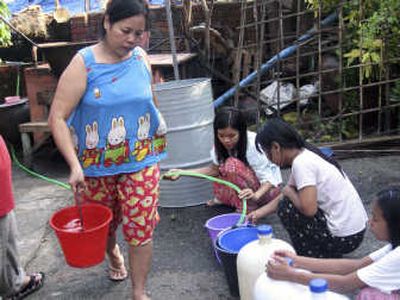10,000 die in one Myanmar town

YANGON, Myanmar – Buddhist monks who demonstrated for democracy in Myanmar last year stepped in Monday to clean up damage from a cyclone in which more than 10,000 people were reported killed in just one town.
The junta’s belated admission that Cyclone Nargis may have taken 30 times more lives than originally reported came just ahead of a referendum on a proposed constitution it hopes will go smoothly in its favor despite opposition from the pro-democracy movement.
Today the death toll continued to mount, with state television reporting that 10,000 perished in the town of Bogalay. It did not give details of the total number of deaths.
Residents of Yangon, the former capital of 6.5 million, complained the government failed to adequately warn them of Saturday’s approaching storm and so far has done little to alleviate their plight.
“The government misled people. They could have warned us about the severity of the coming cyclone so we could be better prepared,” said Thin Thin, a grocery store owner.
Some complained the 400,000-strong military was only clearing streets where the ruling elite reside, while leaving residents, including Buddhist monks, to cope with huge tangles of uprooted trees.
“There are some army trucks out to clear the roads, but most of the work was done with a dah (knife) by the people. Some of these tree trunks are 4-feet thick,” said Barry Broman, a retired U.S. State Department officer who was in Yangon when the cyclone struck. “Thousands of trees were uprooted. All the roads were blocked by the trees.”
The government has said it expects to proceed with Saturday’s referendum.
“The combination of the cyclone and the referendum within a few days of each other makes an angry population angrier and vulnerable and makes the political situation more volatile” than it has been since massive pro-democracy demonstrations last September, which the military violently quashed, said Monique Skidmore, a Myanmar expert at Australian National University.
The casualty count from the cyclone has been rising quickly as authorities reach hard-hit islands and villages in the Irrawaddy delta, the country’s major rice-producing region, which bore the brunt of the storm’s 120 mph winds.
On Monday, prior to state media’s confirmation of 10,000 dead in Bogalay, state radio said 3,939 people perished as high winds and huge storm surges battered coastal areas. In addition, 2,879 people were reported missing in Bogalay, 60 miles south of Yangon.
Foreign Minister Nyan Win also told Yangon-based diplomats the death toll could rise to more than 10,000 in the region that sits barely above sea level, according to Asian diplomats who attended the meeting. With the latest numbers in from Bogalay, the toll was set to surpass this estimate.
Hundreds of thousands have been left homeless and without clean drinking water following Saturday’s cyclone, said Richard Horsey, a spokesman in Bangkok for the U.N. Office for the Coordination of Humanitarian Affairs.
The diplomats said they were told Myanmar, also known as Burma, welcomed international humanitarian aid, including roofing materials, medicine, water purifying tablets and mosquito nets. The first 10-ton shipment was scheduled to arrive today from Thailand.
The appeal for outside assistance was unusual for Myanmar’s ruling generals, who have long been suspicious of international organizations and closely controlled their activities. Several agencies, including the International Red Cross and Doctors Without Borders, have limited their presence as a consequence.
Allowing any major influx of foreigners could carry risks for the military, injecting unwanted outside influence and giving the aid givers rather than the junta credit for a recovery.
However, keeping out international aid would focus blame squarely on the military should it fail to restore peoples’ livelihoods.
Although relief talks with the government were ongoing, the U.N.’s Horsey said it appeared the U.N. had the “green light” to send in a team to assess damage as early as today, and would pull out all the stops to send in food, clean water, blankets and plastic sheeting.
In Washington, first lady Laura Bush said the U.S. Embassy in Myanmar had authorized an emergency contribution of $250,000 to help with relief efforts and was prepared to provide more if the government allows a U.S. disaster assistance response team to enter the country.
“Although they were aware of the threat, Burma’s state-run media failed to issue a timely warning to citizens in the storm’s path. The response to this cyclone is just the most recent example of the junta’s failures to meet its people’s basic needs,” she said.
Washington has long been one of the ruling junta’s sharpest critics for its poor human rights record and failure to hand over power to a democratically elected government.
The government apparently made little effort to prepare for the storm, which came bearing down from the Bay of Bengal late Friday. Although warnings were broadcast on television that 120-mph winds and 12-foot storm surges were predicted, no guidance was given about taking shelter.
In any case, the electricity supply is so spotty in Myanmar that few households, especially in the poor rural areas that were worst hit, would have been aware of the televised warnings.
The government has given no explanation for the high death toll, but most people in the worst-hit region live in bamboo homes with thatch or zinc roofs.
Even in Yangon, the country’s biggest, most modern city, residents were shocked by the destruction. The city, where officials said 59 people died, was without electricity except where gas-fed generators were available and residents lined up to buy candles at double last week’s prices.
“Once the storm subsided, people were walking out to assess the damage and were shocked at everything around them,” said Pamela Sitko, communication relief manager for the Asia-Pacific region for the aid agency World Vision.